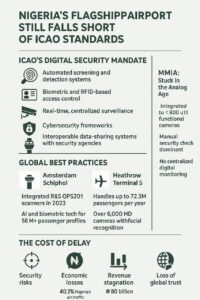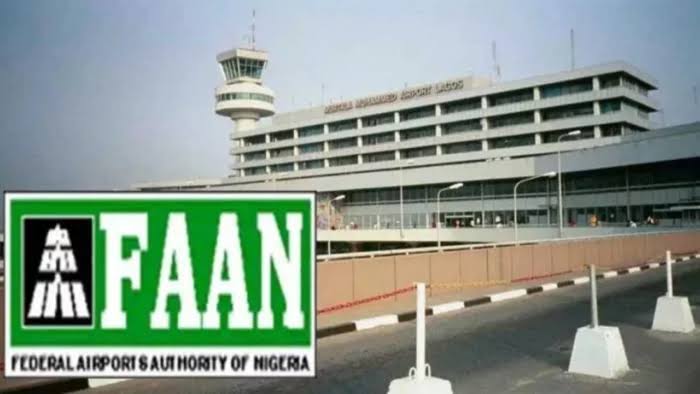Piecemeal Progress, Perpetual Insecurity: Why Nigeria’s Flagship Airport Still Falls Short of ICAO Standards.
By Investigative Correspondent, HeadlineNews.News
When the Federal Airports Authority of Nigeria (FAAN) announced recent upgrades to Murtala Muhammed International Airport (MMIA) in Lagos, many anticipated a transformation aligning with global aviation security standards. However, despite these enhancements, MMIA continues to lag behind the International Civil Aviation Organization’s (ICAO) stringent security requirements—primarily due to the absence of a fully digitalized security architecture.

ICAO’s Digital Security Mandate
ICAO’s Annex 17 to the Convention on International Civil Aviation outlines the requirements for aviation security, calling for states to implement:
Automated screening and detection systems
Biometric and RFID-based access control
Real-time, centralized surveillance
Cybersecurity frameworks
Interoperable data-sharing systems with security agencies
These are not optional enhancements—they are minimum baselines for achieving ICAO certification. Certification opens international aviation partnerships, enhances national credibility, and, most importantly, protects lives.

MMIA: Stuck in the Analog Age
Despite some surface-level infrastructure improvements, MMIA’s current security framework remains outdated:
Surveillance is limited to fewer than 800 functional cameras, many lacking motion detection or AI support
Manual security checks still dominate screening operations
There is no centralized command center or real-time digital monitoring as required by ICAO
This falls far short of ICAO’s 2022 Global Aviation Security Plan, which urges full digitization and predictive security modeling.
Global Best Practices: Europe’s Lead in Airport Security
Consider the standards at top European hubs:
Amsterdam Schiphol Airport
Integrated the R&S QPS201 advanced security scanners in 2023
Uses AI and biometric tech for over 56 million passenger profiles annually
Entire terminal security is managed from a single intelligent operations hub
(Source: Rohde & Schwarz)

Heathrow Airport Terminal 5
Handles up to 72.3 million passengers per year
Over 6,000 HD cameras with facial recognition
Fully digital baggage handling and customs clearance
These airports are ICAO-compliant and serve as examples of what MMIA could become.
The Eden & Mcwhit Global Services Proposal: No-Cost, High-Impact
To solve these deficiencies, Eden & Mcwhit Global Services submitted a Foreign Direct Investment (FDI)-backed proposal to the Federal Government to:
Fully digitalize MMIA’s security architecture
Install AI-powered cameras and analytics
Deploy biometric access for staff and passengers
Establish cybersecurity layers against digital threats
Create a command-and-control center for real-time oversight
Crucially, this proposal requires no capital from the Federal Government. All implementation and maintenance would be handled by Eden & Mcwhit using FDI inflows.

The Cost of Delay
Nigeria’s piecemeal approach comes at a high price:
Security risks: Gaps in surveillance and access control leave MMIA vulnerable
Economic losses: MMIA accounts for 40.3% of Nigeria’s air traffic (Source: Nairametrics). A modernized airport would attract more airlines, travelers, and investors
Revenue stagnation: The MMIA customs area alone generated N80 billion between January–June 2024 (Source: ThisDay). Modernization can unlock more
Loss of global trust: Airlines and international security agencies measure compliance via ICAO certification. Without it, Nigeria is left behind
Meanwhile, countries like Rwanda and Ghana have implemented similar digital models and secured ICAO certification, positioning themselves as regional leaders.

A Call to Action
MMIA should be a symbol of Nigerian excellence, not a reminder of missed opportunities. The Federal Government must rise above bureaucratic inertia and vested interests to approve Eden & Mcwhit’s proposal. The benefits are clear:
Zero cost to the government
Global-standard digital security
ICAO certification potential
Boost in national image and airline traffic
In an age of aviation uncertainty and global scrutiny, security cannot be an afterthought. Let’s fix the roof while the sun shines—because the world is watching.

Headlinenews.news Special Report Team

ICAO SECURITY STANDARDS VS. MMIA COMPLIANCE
1. ICAO Annex 17, Chapter 4.4 – Access Control
ICAO Requirement: Biometric and electronic control of access to restricted areas
MMIA Status: Manual ID checks and physical guards
Compliance Gap: Not compliant
2. ICAO Annex 17, Chapter 4.5 – Surveillance
ICAO Requirement: Real-time digital CCTV and AI monitoring
MMIA Status: Limited, analog surveillance with unlinked cameras
Compliance Gap: Major deficiency
3. ICAO Annex 17, Chapter 5.2 – Screening of Persons/Items
ICAO Requirement: Use of automated, AI-enhanced screening equipment
MMIA Status: Outdated X-ray scanners and manual screening
Compliance Gap: Below ICAO threshold
4. ICAO Annex 17, Chapter 3.1 – Airport Security Programme
ICAO Requirement: Coordinated national security system with intelligence and digital integration
MMIA Status: Fragmented, no unified digital control center
Compliance Gap: Incomplete
5. ICAO Annex 17, Chapter 1.2 – Risk-Based Approach
ICAO Requirement: Threat assessment using digital analytics and cybersecurity
MMIA Status: No cyber-integrated threat detection
Compliance Gap: Non-existent cyber security architecture
COMPARATIVE AIRPORT SECURITY STATISTICS
MMIA – Lagos, Nigeria
Passengers (2023): ~8.2 million
Surveillance: ~800 analog cameras, unlinked
Biometric Use: Partial (manual ID checks)
AI/Smart Tech: None
Heathrow Terminal 5 – UK
Passengers: 72.3 million
Surveillance: Over 6,000 smart HD cameras with facial recognition
Biometric Use: Full
AI/Smart Tech: Yes, centralized command
Amsterdam Schiphol – Netherlands
Passengers: 56 million
Surveillance: Fully AI-integrated surveillance system
Biometric Use: Full
AI/Smart Tech: Yes
Kigali International (New Terminal) – Rwanda
Passengers: ~2.1 million (8M projected)
Surveillance: Full coverage, real-time monitoring
Biometric Use: Full
AI/Smart Tech: Yes, ICAO-certified
Headlinenews.news Special Reporting Team.



